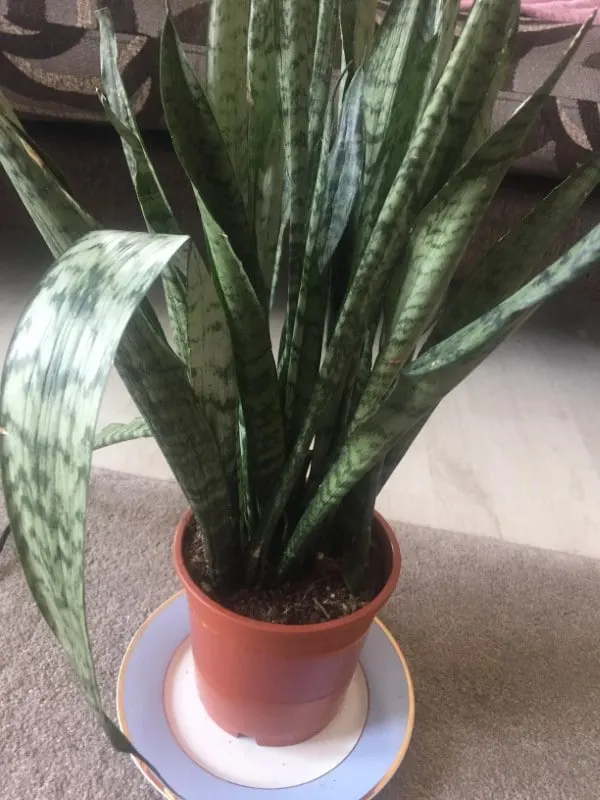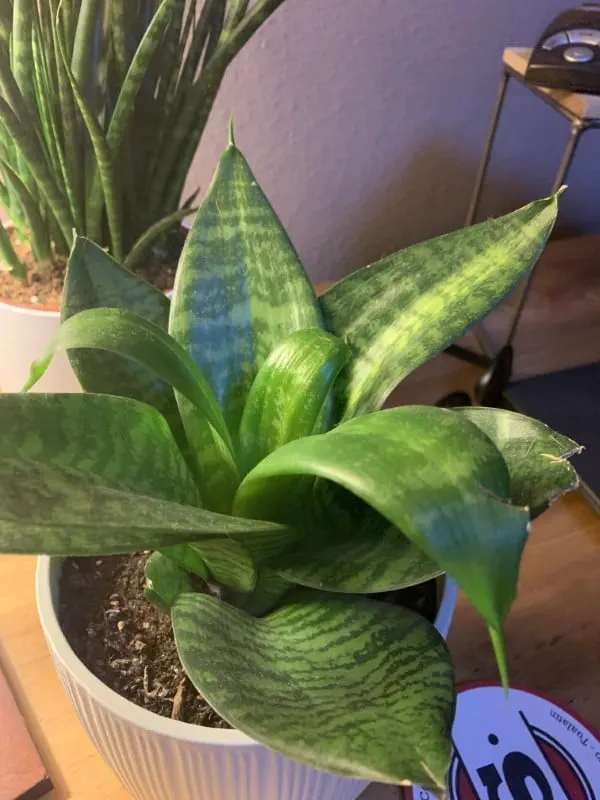Dracaena trifasciata, commonly known as snake plant or Sansevieria, is a beautiful, tropical plant with long leaves. It is also known by the name “mother-in-law’s tongue.” The fruit produced on its trunk can grow up to 15 feet tall.
If you find your snake plant leaves curling and want to fix the problem, identifying what could be causing them can help. The following article entails the answer to the question, “why is my snake plant curling.” Please continue reading to know the reason and ways to fix it.

Why Is My Snake Plant Curling?
It’s important to identify the specific reason why your snake plant leaves are curling. You have to look at symptoms and figure out what might be causing issues.
Therefore, you can offer them an effective treatment plan that fixes their problem quickly. Here are the factors which cause snake plants’ leaves to curl.
1. Overwatering
Overwatering is the number one cause of curly leaves in snake plants. When they are soggy, it suffocates their roots and stops them from getting nutrients or moisture. On the other hand, giving your snake plant too much water will develop root rot.
The fungal disease causes roots to become dysfunctional and unable to uptake necessary nutrients. These leaves may start curling up when dry deprived of vital nutrients for normal growth. There are three ways to tell if your plant has been overwatered.
First, take out the whole pot and look at its roots – you will see that they have brown or black edges where excess soil has accumulated on them. Second, you might notice wilted leaves with too much moisture in their environment.
So, check either by taking off some of these wilting sections before watering again or watch how quickly water droplets evaporate from leaf margins. Thirdly try planting less but opting for bigger containers. It can help limit excess nutrient consumption rates without causing root-bound issues.

2. Dry Soil
Sansevieria is drought resistant, but consistent underwatering can lead to a lack of nutrients. Without enough water, your snake plant will not carry out its normal functioning, such as photosynthesis and transpiration.
When there isn’t enough moisture available for these processes, this leads to lateral wilting & brown leaves, decreased growth rate, etc.
3. Lack Of Light
Snake plant is known to be one of the best houseplants that do well with indoor light conditions. But if it doesn’t get enough sunlight or heat from a window, the leaves can curl up at their edges due to the leaf scorching.
4. Inadequate Temperature
Sansevieria plants are sensitive to extreme temperatures. If exposed too long or heat is applied without consideration, it can lead the plant into danger. Due to low temperatures, the water within the leaves freezes and forms crystals, which causes permanent damage to the leaves.
5. Fungal Infections
The snake plant can be prone to fungal infections. If you notice brown spots on the leaves or curling up, the chances are that it’s suffering from some fungal or mold infection. Southern Blight and Red Leaf Spot are two such diseases that damage roots as well as leaves.
6. High Humidity
High humidity levels may also cause problems as well since this accelerates transpiration rates in potted Sansevieria leaves. As a result, it causes the plant to lose water more than usual, resulting in twisted leaves with time if left unchecked.
7. Excessive Fertilizer Application
As snake plants are not heavy feeders, fertilizing them will lead to curled leaves. Again, the plant needs to allocate its resources towards growing new roots rather than leaf growth.
Solution For Snake Plant Curling
Snake plants are one of the easiest houseplants to take care of. All they need is just enough moisture without getting too much light on their roots or potting soil. It will ensure that these lovable beings thrive indoors while remaining green year-round.
Avoid Over Watering
If you water your snake plant at short intervals, the roots become logged. You could avoid this issue if you took a lighter approach by watering only, when necessary, instead of drenching them every day or so. This plant doesn’t need water unless its soil is almost fully dry.
Make sure that you’re giving them enough to keep the roots moist but not sopping wet. Be careful about over-watering or letting potting mix drench too deep in some cases where it might block drainage holes on the bottom.
Water Only When Soil Is Dry
To avoid curling and dry out the leaves on your snake plant, make sure you water it only when the potting soil has almost dried. It would be best to water this plant once in 2-4 weeks.
Place Near The Window
To avoid the snake plant’s leaves curling up, place it near the window. It is an easy fix- find someplace where there’s direct sun all day long. Indoor light could also suffice for your snake plant to thrive.
Give Right Temperature
Snake plant needs a temperature of about 55-85°F (13 – 29 Celsius) for optimal growth and development of their roots.
Keep Away From Fungal Infections
Cut off the knobby ends of leaves to reduce fungal infections. Avoid overwatering and keep it in bright, filtered light to prevent spreading fungus damage throughout your plant’s system.
Right Use Of Fertilizers
For optimal growth of your snake plant and avoiding curly leaves, use a slow-releasing nitrogen-rich fertilizer and use it according to the instructions on its label. Avoid feeding your plant every month.
Conclusion
The snake plant is an evergreen plant that produces dense stands and spreads using its creeping rhizome. The common issue with this plant is its leaves curling, and its main cause is overwatering.
- Snake plants typically develop curly leaves due to overwatering.
- Other possible reasons for the curly leaves on your snake plant could be over-fertilization, temperature stress, insufficient lighting, and fungal infections.
- The solutions mentioned above will help you avoid curly or twisted leaves resulting in a healthy green snake plant. We’ve got all your answers in a convenient comment section below, so go ahead and ask!
